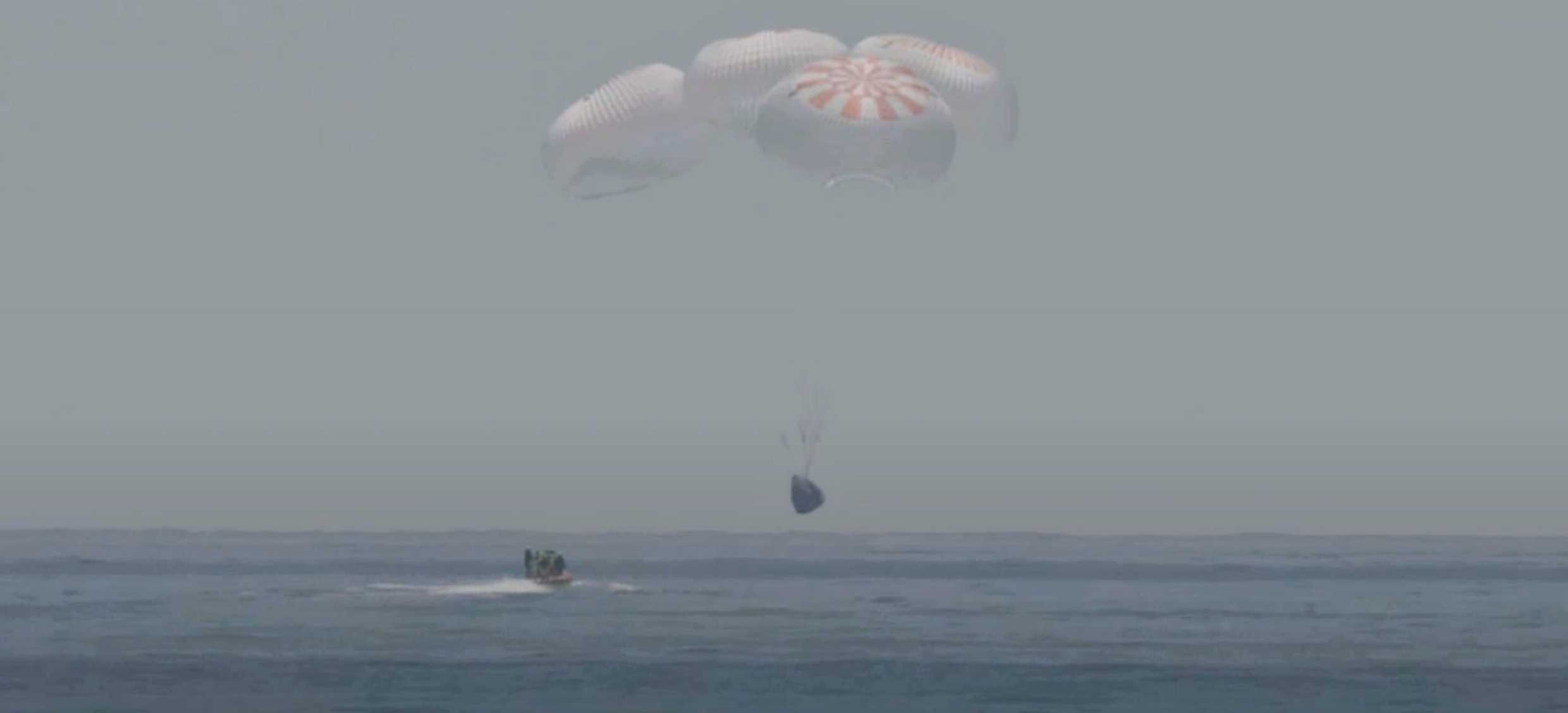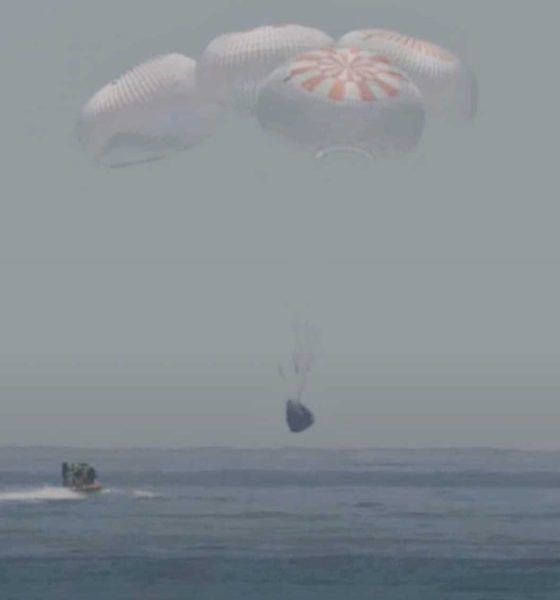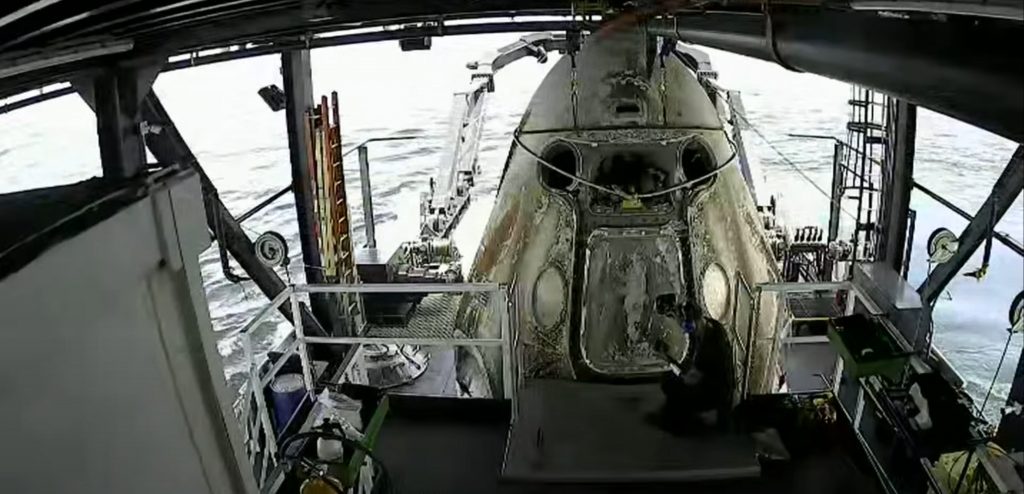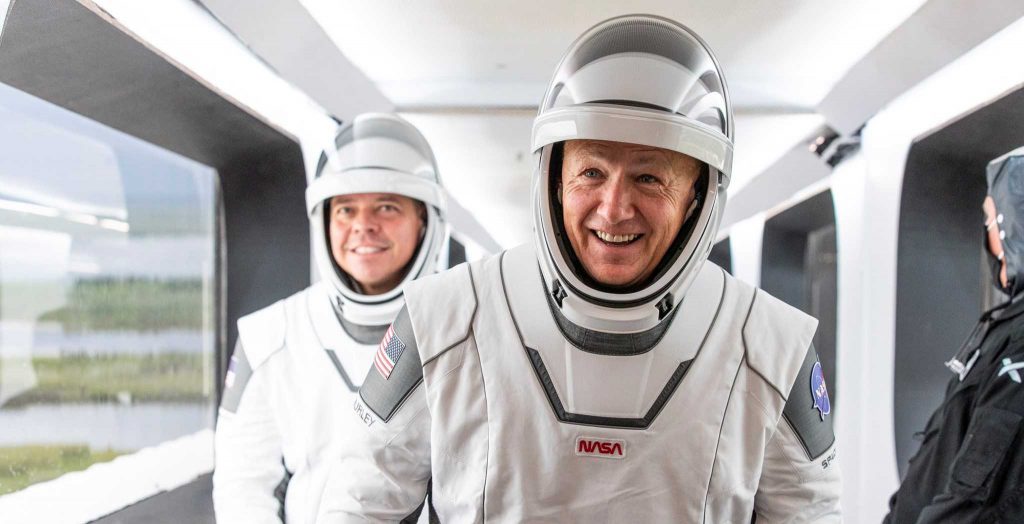

News
SpaceX lands NASA astronauts in the ocean for the first time in decades
SpaceX has successfully landed NASA astronauts in the ocean for the first time in almost half a century, completing the most important mission in the company’s history and setting it up for an imminent operational launch debut.
Roughly 19 hours after NASA astronauts Bob Behnken and Doug Hurley boarded Crew Dragon and departed the International Space Station (ISS), the spacecraft ejected its trunk section and commanded a final reentry burn. 40 minutes later, Crew Dragon and its two astronaut occupants truly began to reenter Earth’s atmosphere traveling some 20-25 times the speed of sound, producing superheated plasma that prevents communication with the ground for around 10 minutes.
Right on schedule, SpaceX headquarters reacquired Crew Dragon’s signal, confirming that it had successfully made it through what CEO Elon Musk deemed the single riskiest moment of the mission prior to launch.
Finally, around 11:48 am EDT (15:48 UTC), Crew Dragon – having successfully deployed drogue and main parachutes for the second time after an orbital launch – gently splashed down in the ocean. In a global spaceflight first, Crew Dragon actually splashed down in the Gulf of Mexico off the coast of Pensacola, Florida. For NASA, it’s the first time astronauts have actually splashed down since the final Apollo Command and Service Module (CSM) capsule launch in July 1975, more than 45 years ago.

Despite at least a dozen extraordinarily irresponsible private boaters trespassing on the highly sensitive and dangerous post-splashdown recovery operations and an inexplicable lack of Coast Guard enforcement, SpaceX teams managed to bring Crew Dragon and its passengers aboard recovery vessel GO Searcher just half an hour or so after splashdown.
After purging Crew Dragon’s service section to get rid of slightly off-nominal concentrations of dinitrogen tetroxide (NTO) oxidizer, the spacecraft’s hatch was finally opened at 1 pm EDT (17:00 UTC), around 80 minutes after splashdown. Astronaut Bob Behnken exited the capsule first around 8 minutes later, followed by mission commander Doug Hurley shortly thereafter.

The successful return of Behnken and Hurley marks the completion of Crew Dragon’s inaugural Demo-2 astronaut launch and officially ends nine years NASA spent without the domestic ability to launch its own astronauts. Incredibly, NASA and SpaceX plan to waste no time to attempt an even more ambitious crewed launch – Crew Dragon’s operational astronaut launch debut.
Known as Crew-1 and scheduled to launch as early as late September, less than two months from now, Crew Dragon C206’s safe recovery means that SpaceX and NASA can begin an extensive review and (hopefully) qualify the spacecraft for operational launches. Aside from a new Crew Dragon capsule expected to arrive in Florida just a week or so from now, it’s believed that all rocket hardware is already on site for Crew-1.
A step further, the very capsule that just successfully returned NASA astronauts to Earth is scheduled to be reused as few as seven months from now on SpaceX’s second operational astronaut launch, Crew-2. According to SpaceX, the refurbishment process may have already begun and should be complete just a few months from now, offering at least as many months of buffer.
Check out Teslarati’s Marketplace! We offer Tesla accessories, including for the Tesla Cybertruck and Tesla Model 3.

News
Tesla FSD fleet is nearing 7 billion total miles, including 2.5 billion city miles
As can be seen on Tesla’s official FSD webpage, vehicles equipped with the system have now navigated over 6.99 billion miles.

Tesla’s Full Self-Driving (Supervised) fleet is closing in on almost 7 billion total miles driven, as per data posted by the company on its official FSD webpage.
These figures hint at the massive scale of data fueling Tesla’s rapid FSD improvements, which have been quite notable as of late.
FSD mileage milestones
As can be seen on Tesla’s official FSD webpage, vehicles equipped with the system have now navigated over 6.99 billion miles. Tesla owner and avid FSD tester Whole Mars Catalog also shared a screenshot indicating that from the nearly 7 billion miles traveled by the FSD fleet, more than 2.5 billion miles were driven inside cities.
City miles are particularly valuable for complex urban scenarios like unprotected turns, pedestrian interactions, and traffic lights. This is also the difference-maker for FSD, as only complex solutions, such as Waymo’s self-driving taxis, operate similarly on inner-city streets. And even then, incidents such as the San Francisco blackouts have proven challenging for sensor-rich vehicles like Waymos.
Tesla’s data edge
Tesla has a number of advantages in the autonomous vehicle sector, one of which is the size of its fleet and the number of vehicles training FSD on real-world roads. Tesla’s nearly 7 billion FSD miles then allow the company to roll out updates that make its vehicles behave like they are being driven by experienced drivers, even if they are operating on their own.
So notable are Tesla’s improvements to FSD that NVIDIA Director of Robotics Jim Fan, after experiencing FSD v14, noted that the system is the first AI that passes what he described as a “Physical Turing Test.”
“Despite knowing exactly how robot learning works, I still find it magical watching the steering wheel turn by itself. First it feels surreal, next it becomes routine. Then, like the smartphone, taking it away actively hurts. This is how humanity gets rewired and glued to god-like technologies,” Fan wrote in a post on X.
News
Tesla starts showing how FSD will change lives in Europe
Local officials tested the system on narrow country roads and were impressed by FSD’s smooth, human-like driving, with some calling the service a game-changer for everyday life in areas that are far from urban centers.

Tesla has launched Europe’s first public shuttle service using Full Self-Driving (Supervised) in the rural Eifelkreis Bitburg-Prüm region of Germany, demonstrating how the technology can restore independence and mobility for people who struggle with limited transport options.
Local officials tested the system on narrow country roads and were impressed by FSD’s smooth, human-like driving, with some calling the service a game-changer for everyday life in areas that are far from urban centers.
Officials see real impact on rural residents
Arzfeld Mayor Johannes Kuhl and District Administrator Andreas Kruppert personally tested the Tesla shuttle service. This allowed them to see just how well FSD navigated winding lanes and rural roads confidently. Kruppert said, “Autonomous driving sounds like science fiction to many, but we simply see here that it works totally well in rural regions too.” Kuhl, for his part, also noted that FSD “feels like a very experienced driver.”
The pilot complements the area’s “Citizen Bus” program, which provides on-demand rides for elderly residents who can no longer drive themselves. Tesla Europe shared a video of a demonstration of the service, highlighting how FSD gives people their freedom back, even in places where public transport is not as prevalent.
What the Ministry for Economic Affairs and Transport says
Rhineland-Palatinate’s Minister Daniela Schmitt supported the project, praising the collaboration that made this “first of its kind in Europe” possible. As per the ministry, the rural rollout for the service shows FSD’s potential beyond major cities, and it delivers tangible benefits like grocery runs, doctor visits, and social connections for isolated residents.
“Reliable and flexible mobility is especially vital in rural areas. With the launch of a shuttle service using self-driving vehicles (FSD supervised) by Tesla in the Eifelkreis Bitburg-Prüm, an innovative pilot project is now getting underway that complements local community bus services. It is the first project of its kind in Europe.
“The result is a real gain for rural mobility: greater accessibility, more flexibility and tangible benefits for everyday life. A strong signal for innovation, cooperation and future-oriented mobility beyond urban centers,” the ministry wrote in a LinkedIn post.
News
Tesla China quietly posts Robotaxi-related job listing
Tesla China is currently seeking a Low Voltage Electrical Engineer to work on circuit board design for the company’s autonomous vehicles.

Tesla has posted a new job listing in Shanghai explicitly tied to its Robotaxi program, fueling speculation that the company is preparing to launch its dedicated autonomous ride-hailing service in China.
As noted in the listing, Tesla China is currently seeking a Low Voltage Electrical Engineer to work on circuit board design for the company’s autonomous vehicles.
Robotaxi-specific role
The listing, which was shared on social media platform X by industry watcher @tslaming, suggested that Tesla China is looking to fill the role urgently. The job listing itself specifically mentions that the person hired for the role will be working on the Low Voltage Hardware team, which would design the circuit boards that would serve as the nervous system of the Robotaxi.
Key tasks for the role, as indicated in the job listing, include collaboration with PCB layout, firmware, mechanical, program management, and validation teams, among other responsibilities. The role is based in Shanghai.
China Robotaxi launch
China represents a massive potential market for robotaxis, with its dense urban centers and supportive policies in select cities. Tesla has limited permission to roll out FSD in the country, though despite this, its vehicles have been hailed as among the best in the market when it comes to autonomous features. So far, at least, it appears that China supports Tesla’s FSD and Robotaxi rollout.
This was hinted at in November, when Tesla brought the Cybercab to the 8th China International Import Expo (CIIE) in Shanghai, marking the first time that the autonomous two-seater was brought to the Asia-Pacific region. The vehicle, despite not having a release date in China, received a significant amount of interest among the event’s attendees.








